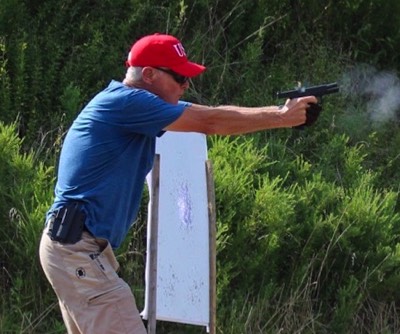Marksman or Gunfighter?
I just spent an incredible nine hours training with some of the best firearms instructors in the state. You might think nine hours is a long time for training, but I had a blast. The time flew by as we were taught how to shoot better, faster, and ultimately to be both effective and efficient in the Intuitive Defensive Shooting Program. That training really got me thinking. The old cliché that “it's like riding a bike” applies to many things. When it comes to complex tasks, you might remember how to do it, i.e., riding a bike, but you won't retain the ability to do it well without extensive practice.
Firearms training has two major components in my opinion. The first is working on basic marksmanship. The other component is our ability to use our firearm in combat, which I will label gunfighting skills for lack of a better term. I asked you this question, which are you, a marksman or gunfighter?
The marksman should be able to pick up his/her chosen firearm, load it properly, and understand the fundamentals of stance, grip, sight picture/alignment, breathing, and trigger squeeze in order to put lead on the target. An expert marksman would be able to do those things in such a way that he or she would be accurate and consistent. I think most people believe if they can go to the range and get 20 rounds on the target, then they can defend themselves well enough. Who am I to disagree? Instead of chastising great marksmen for accepting the status quo, I will let you decide if that is enough.
So what then makes the difference between the great marksman and a gunfighter? I bet most people would say the gunfighter understands how to shoot and move while the marksman is more of a static shooter. That could be true, but let me enter the one variable that makes the difference. A gunfighter understands jeopardy and trains for it.
In the military, I was trained to shoot the 300-meter target with my M16. I had time, a stable platform, and the expertise to hit that target (with training and practice). Basic rifle marksmanship works well sitting in a foxhole with interlocking fields of fire, assuming that the enemy would have to expose himself, while I was watching his approach. At 300 meters, those targets would be unlikely to see me in the safety of my foxhole. My silhouette would be low, and I would be minimally exposed. Once I went to combat, I realized there were no foxholes. We kicked in doors and were fully exposed at close range. We moved up mountains and through wadis (trenches) to engage the enemy. It didn't take long for me to realize that I only had one chance to get my shot off under pressure before the enemy took his shot. I learned to shoot, move, and communicate with the support of other troops.
I served for several years in law enforcement and again found myself relying on gunfighting skills rather than the safety of cover and concealment. Of course, we are trained in law enforcement to take cover behind automobiles or even a low wall, but more often than not, warrant service required us to kick in doors and clear the area quickly. We were in jeopardy every single time.
So what training is required to become a gunfighter? First and foremost, marksmanship training is required. We absolutely have to be able to get on target. If we can’t hit the target from a comfortable position, without the stress of incoming fire, then we certainly can't progress with advanced skills. Let me be clear: we must be able to do the basics first.
I pray those reading this article understand what I'm talking about when it comes to marksmanship training. If not, please contact us and come to a basic pistol/rifle marksmanship class and we will teach you. I must also assume that many people have no idea what these gunfighting skills include. The following questions will give you an idea of what you could be missing without advanced training.
I could go on and on with these questions and some of you would nod your head, but many of you would have to go to Google to find answers. My point is this. If you are going to own a firearm for the purpose of self-defense, wouldn't you want to be more than just a basic marksman? If you are going to open carry or carry concealed, are you prepared to draw your firearm in self-defense while in jeopardy? If you said yes to these questions, then please take additional training and consider gunfighting rather than just shooting paper.
Sometimes a metaphor is helpful so let me paint this picture for you. Most people know what baseball is all about. Many people can throw, catch, and even hit the baseball. Not everyone wants to play for the major leagues, but everyone understands there's a huge difference in training when you compare it to Little League baseball. Many of us played as kids, and the training required play in the major leagues is by far more intensive and comprehensive. Carrying a firearm for self-defense is the major leagues. The real question is this... Are you trained well enough to survive a life-and-death scenario?
Curtiss Robinson, MA NSCA-CPT
Owner/Instructor at ConwayToe2Toe
Affiliate Instructor with GetTrainedBeReady.com
If you would like more information about our Firearms Instructor courses, reach out to us. We stand by to help.
Come train with us: https://www.gettrainedbeready.com/calendar/
Curtiss Robinson.
The marksman should be able to pick up his/her chosen firearm, load it properly, and understand the fundamentals of stance, grip, sight picture/alignment, breathing, and trigger squeeze in order to put lead on the target. An expert marksman would be able to do those things in such a way that he or she would be accurate and consistent. I think most people believe if they can go to the range and get 20 rounds on the target, then they can defend themselves well enough. Who am I to disagree? Instead of chastising great marksmen for accepting the status quo, I will let you decide if that is enough.
So what then makes the difference between the great marksman and a gunfighter? I bet most people would say the gunfighter understands how to shoot and move while the marksman is more of a static shooter. That could be true, but let me enter the one variable that makes the difference. A gunfighter understands jeopardy and trains for it.
In the military, I was trained to shoot the 300-meter target with my M16. I had time, a stable platform, and the expertise to hit that target (with training and practice). Basic rifle marksmanship works well sitting in a foxhole with interlocking fields of fire, assuming that the enemy would have to expose himself, while I was watching his approach. At 300 meters, those targets would be unlikely to see me in the safety of my foxhole. My silhouette would be low, and I would be minimally exposed. Once I went to combat, I realized there were no foxholes. We kicked in doors and were fully exposed at close range. We moved up mountains and through wadis (trenches) to engage the enemy. It didn't take long for me to realize that I only had one chance to get my shot off under pressure before the enemy took his shot. I learned to shoot, move, and communicate with the support of other troops.
I served for several years in law enforcement and again found myself relying on gunfighting skills rather than the safety of cover and concealment. Of course, we are trained in law enforcement to take cover behind automobiles or even a low wall, but more often than not, warrant service required us to kick in doors and clear the area quickly. We were in jeopardy every single time.
So what training is required to become a gunfighter? First and foremost, marksmanship training is required. We absolutely have to be able to get on target. If we can’t hit the target from a comfortable position, without the stress of incoming fire, then we certainly can't progress with advanced skills. Let me be clear: we must be able to do the basics first.
I pray those reading this article understand what I'm talking about when it comes to marksmanship training. If not, please contact us and come to a basic pistol/rifle marksmanship class and we will teach you. I must also assume that many people have no idea what these gunfighting skills include. The following questions will give you an idea of what you could be missing without advanced training.
- Can you clear a simple malfunction under fire?
- Can you clear a complex malfunction under fire?
- Can you reload on the move and under fire?
- Do you understand lateral and linear movement?
- Can you shoot, reload, and execute proper lateral movement while under fire?
- Do you understand reflexive fire?
I could go on and on with these questions and some of you would nod your head, but many of you would have to go to Google to find answers. My point is this. If you are going to own a firearm for the purpose of self-defense, wouldn't you want to be more than just a basic marksman? If you are going to open carry or carry concealed, are you prepared to draw your firearm in self-defense while in jeopardy? If you said yes to these questions, then please take additional training and consider gunfighting rather than just shooting paper.
Sometimes a metaphor is helpful so let me paint this picture for you. Most people know what baseball is all about. Many people can throw, catch, and even hit the baseball. Not everyone wants to play for the major leagues, but everyone understands there's a huge difference in training when you compare it to Little League baseball. Many of us played as kids, and the training required play in the major leagues is by far more intensive and comprehensive. Carrying a firearm for self-defense is the major leagues. The real question is this... Are you trained well enough to survive a life-and-death scenario?
Curtiss Robinson, MA NSCA-CPT
Owner/Instructor at ConwayToe2Toe
Affiliate Instructor with GetTrainedBeReady.com
If you would like more information about our Firearms Instructor courses, reach out to us. We stand by to help.
Come train with us: https://www.gettrainedbeready.com/calendar/
Curtiss Robinson.

